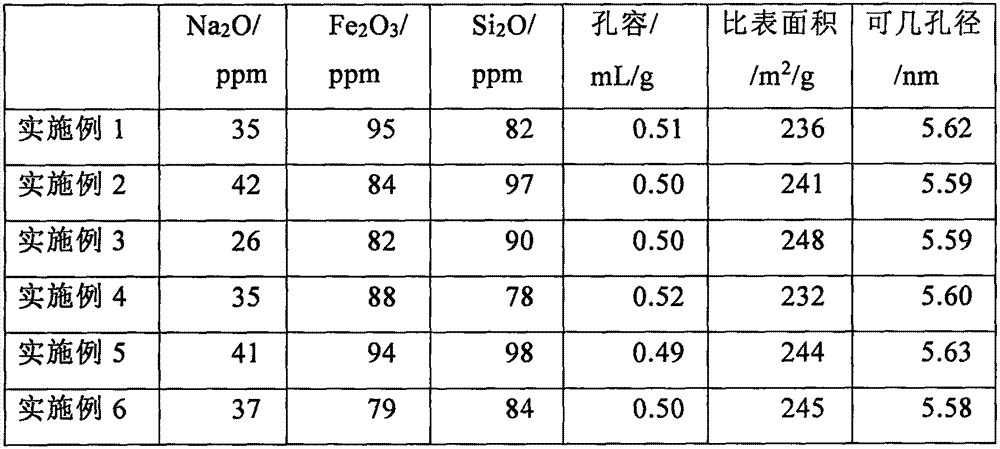Preparation method of highly pure pseudoboehmite
A pseudo-boehmite and high-purity technology, which is applied in the field of high-purity pseudo-boehmite preparation, can solve the problems of uneven pore size, low crystal phase purity, and unstable products, and achieve stable products and no three wastes Emission, the effect of a single crystal phase
- Summary
- Abstract
- Description
- Claims
- Application Information
AI Technical Summary
Problems solved by technology
Method used
Image
Examples
Embodiment 1
[0021] Add 10 grams of metallic aluminum, 0.02 grams of aluminum trichloride and 63 grams of n-hexanol into a four-neck flask, heat to 110°C to start the reaction, and slowly drop 126 grams of n-hexanol into the flask when a large number of bubbles are generated in the flask. After the reaction was completed, 99.7 g of trimethylbenzene was added to the flask, the temperature was raised to 110° C., and a mixture of tri-n-hexyloxyaluminum and trimethylbenzene was obtained by filtration. Add 30 mL of deionized water into the flask and raise the temperature to 85°C. A mixture of tri-n-hexaneoxyaluminum and trimethylbenzene at a temperature of 85°C was added dropwise to the flask while stirring was started, and the dropwise addition was completed in 30 minutes. The mixture of n-hexanol and trimethylbenzene produced by the hydrolysis of aluminum alkoxide was extracted from the flask. Add 225mL of deionized water to the flask and raise the temperature to 85°C, age for 12 hours and t...
Embodiment 2
[0023] The mixture of n-hexanol and trimethylbenzene extracted after the completion of hydrolysis in Example 1 continues to be used after dehydration treatment. Add a mixture of 10 grams of aluminum metal, 0.01 grams of aluminum trichloride, 0.01 grams of aluminum n-hexyl alcohol and 96.7 grams of n-hexanol and trimethylbenzene into a four-necked flask, and heat to 120°C to start the reaction. When a large number of bubbles are generated in the flask, the remaining n-hexanol and The trimethylbenzene mixture was slowly added dropwise into the flask, and filtered to obtain a mixture of tri-n-hexyloxyaluminum and trimethylbenzene. Add 30 mL of deionized water into the flask, raise the temperature to 85°C, and start stirring. Add the mixture of aluminum alkoxide and trimethylbenzene dropwise to the flask, and the dropwise addition is completed in 30 minutes. The mixture of n-hexanol and trimethylbenzene produced by the hydrolysis of aluminum alkoxide was extracted from the flask....
Embodiment 3
[0025] Add 10 grams of aluminum metal, 0.02 grams of aluminum trichloride and 45.7 grams of n-butanol into a four-necked flask, and heat to 100°C to start the reaction. When a large number of bubbles are generated in the flask, slowly drop 91.3 grams of n-butanol into the flask. After the reaction was completed, 90 grams of 200# solvent oil was added to the flask, the temperature was raised to 110° C., and the mixture of aluminum alkoxide and mesitylene was obtained by filtration. Add 30 mL of deionized water into the flask, raise the temperature to 85°C, and start stirring. Add the mixture of aluminum alkoxide and 200# solvent naphtha dropwise to the flask, and the dropwise addition is completed in 30 minutes. Extract the mixture of n-butanol and 200# solvent naphtha produced by the hydrolysis of aluminum alkoxide from the flask. Add 225mL of deionized water to the flask and raise the temperature to 85°C, age for 12 hours and then filter. The filter cake was dried at 120°C ...
PUM
 Login to View More
Login to View More Abstract
Description
Claims
Application Information
 Login to View More
Login to View More - R&D
- Intellectual Property
- Life Sciences
- Materials
- Tech Scout
- Unparalleled Data Quality
- Higher Quality Content
- 60% Fewer Hallucinations
Browse by: Latest US Patents, China's latest patents, Technical Efficacy Thesaurus, Application Domain, Technology Topic, Popular Technical Reports.
© 2025 PatSnap. All rights reserved.Legal|Privacy policy|Modern Slavery Act Transparency Statement|Sitemap|About US| Contact US: help@patsnap.com

